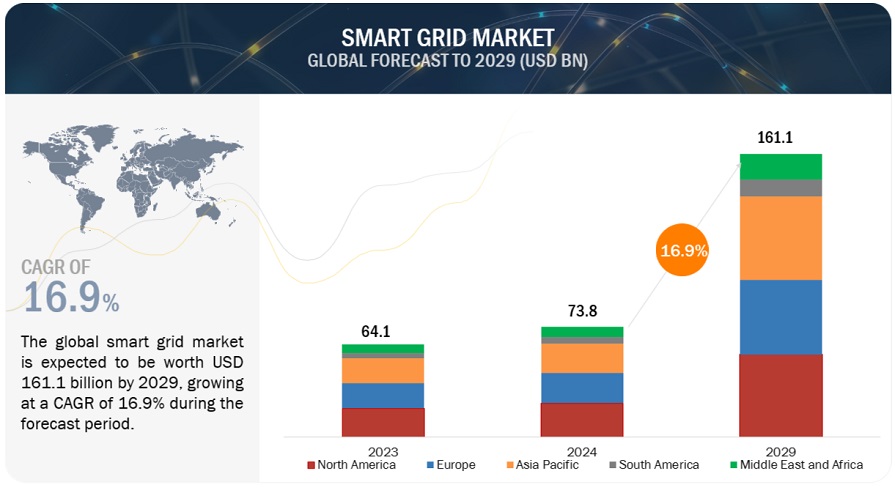The global Smart Grid Market in terms of revenue was estimated to be worth $73.8 billion in 2024 and is poised to reach $161.1 billion by 2029, growing at a CAGR of 16.9% from 2024 to 2029 according to a new report by MarketsandMarkets™.

The global demand for smart grid is increasing due to strong focus on modernization of aging grid infrastructure. Factors such as rapid industrialization, urbanization, and rising requirement for energy efficiency are driving this growth. The demand for smart grid is growing due to the supportive regulatory framework of governments worldwide to promote deployment of smart grids and spreading awareness about energy conservation. Additionally, With the increasing complexity of the bulk power system and the growing focus on mitigating power outages, smart grid technology is poised to transform the traditional grid and is likely to become a more reliable and resilient approach.
The demand for smart grid is growing globally due to increasing requirement for smart energy infrastructure, which is driven by rising energy demand. Rapid industrialization and urbanization contribute to rising energy consumption from industrial, commercial, and residential end users.
Download PDF Brochure: https://www.marketsandmarkets.com/pdfdownloadNew.asp?id=208777577
Transmission is expected to emerge as the fastest-growing segment in the smart grid market.
The smart grid market has been segmented based on application into generation, transmission, Distribution and consumption . The smart grid market’s transmission segment is expanding at the fastest pace because it is in line with the changing energy landscape. An efficient automated transmission network can carry energy from bulk generation facilities to power distribution systems when required. Transmission of power from the generating station to the distribution system has appropriate communication interfaces with the effective participation of the system operator.
Wireless Communication technology is expected to be the second largest segment during the forecast period.
The wireless segment is growing in the Smart Grid Market owing to increasing variable energy requirement due to expansion in industries such as manufacturing, automotive, construction, power generation, and chemical production. The variable energy requirement and demand response can be fulfilled only by adapting smart grid solutions. Wireless technology offers integral support to the utilities by offering high bandwidth, covering a large area, and optimizing complex logistics and production processes. These technologies are used in several applications, such as distribution automation, substation automation, transmission lines, and power plants. Wireless communication technology enables to automate substations. Consequently, driving the demand for wireless communication.
Request Sample Pages: https://www.marketsandmarkets.com/requestsampleNew.asp?id=208777577
North America is expected to be the largest region for the smart grid market.
North America is the fastest-growing market for smart grid owing to several key factors. The region is witnessing a substantial increase in renewable energy projects, particularly in solar and wind, spurred by government initiatives, tax incentives, and heightened environmental awareness. The United States, in particular, is leading the charge in the adoption of clean energy solutions, creating a strong demand for smart grid technologies to efficiently integrate these renewable sources into the power grid. Advancements in smart grid technology are central to this growth, enabling better energy management, real-time data analytics, and enhanced grid reliability. The electrification of various industries, coupled with the surge in electric vehicle (EV) adoption, further accelerates the deployment of smart grids, as they are essential for supporting the necessary charging infrastructure. As consumers and businesses in North America increasingly prioritize sustainability, the market for smart grid solutions is expanding rapidly. Technological innovations, such as improved data analytics and predictive maintenance, are critical in managing the vast amounts of data generated by smart grids, ensuring efficient energy distribution and minimizing outages. Regulatory support and policies favoring clean energy and technological advancements play pivotal roles in shaping the dynamic and expanding landscape of the smart grid market in North America. This confluence of factors positions the region as a leader in the adoption and implementation of smart grid technologies, paving the way for a more sustainable and efficient energy future.
Key Players
Some of the major players in the Smart Grid Market are General Electric Company (US), ABB (Switzerland), Siemens (Germany), Schneider Electric (France), Wipro (India), Globema (Poland), Trilliant Holdings (US), Kamstrup (Denmark), Tech Mahindra (India), Oracle (US), Cisco (US), Eaton (Ireland), ENEL X (Italy), Grid4C (US), Mitsubishi Electric (Japan), and Itron (US) among others.


